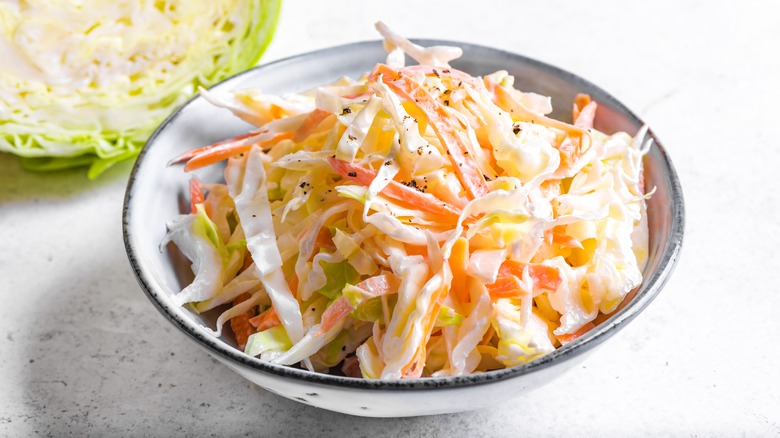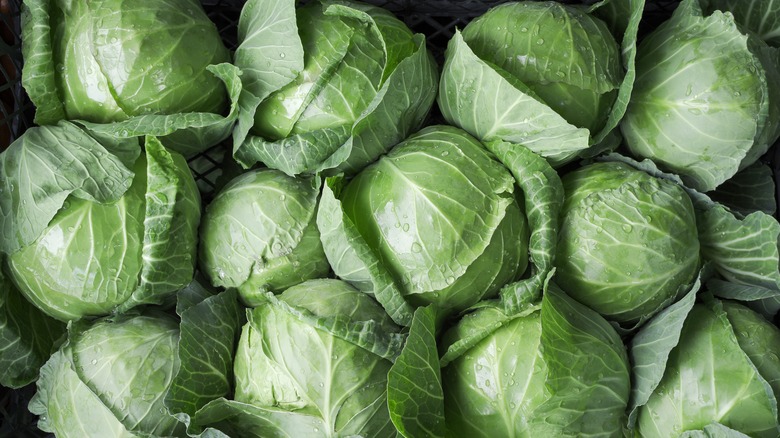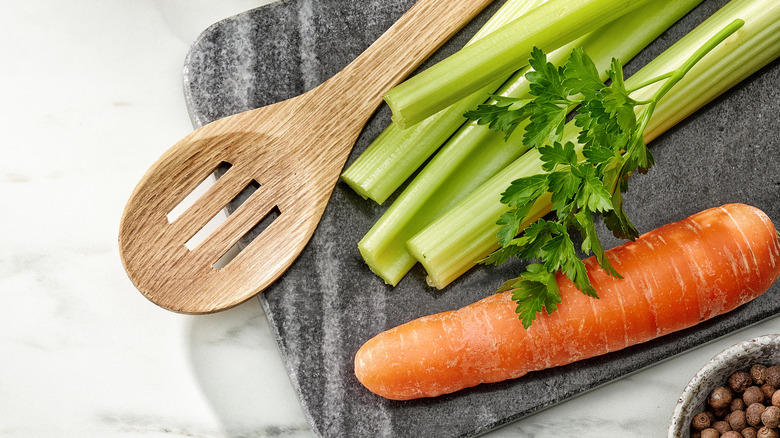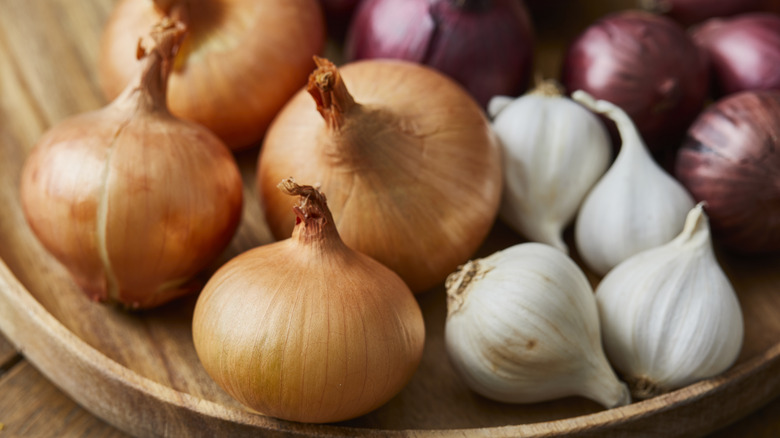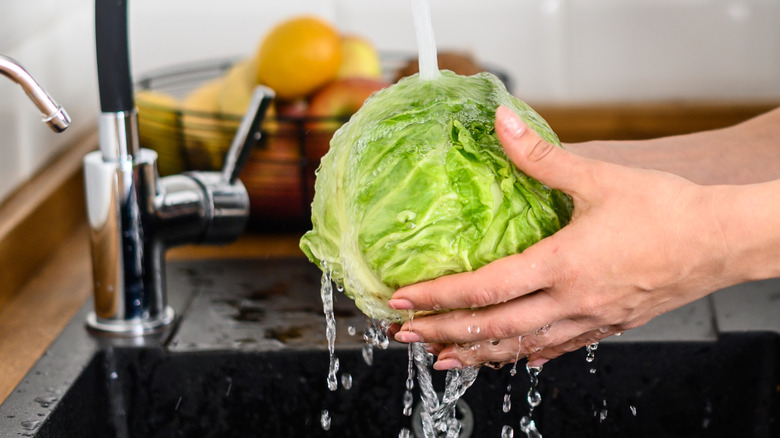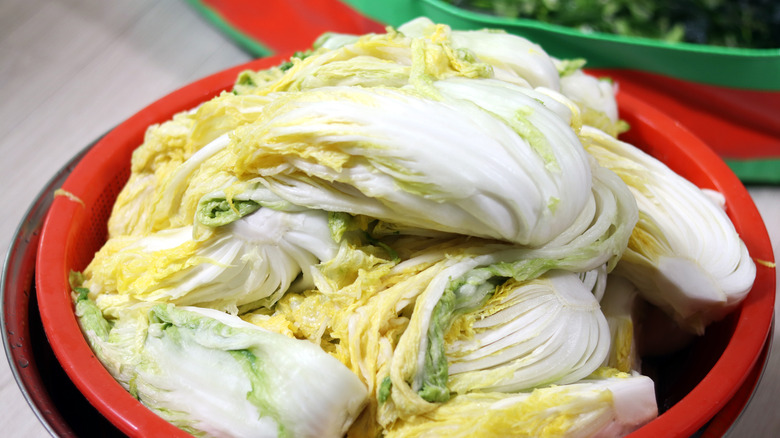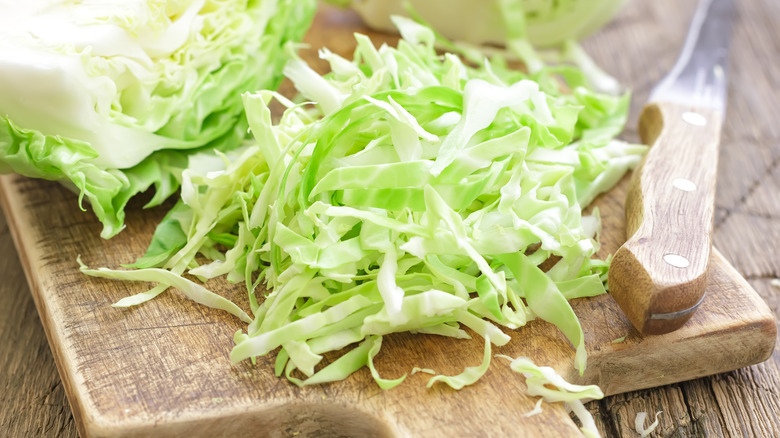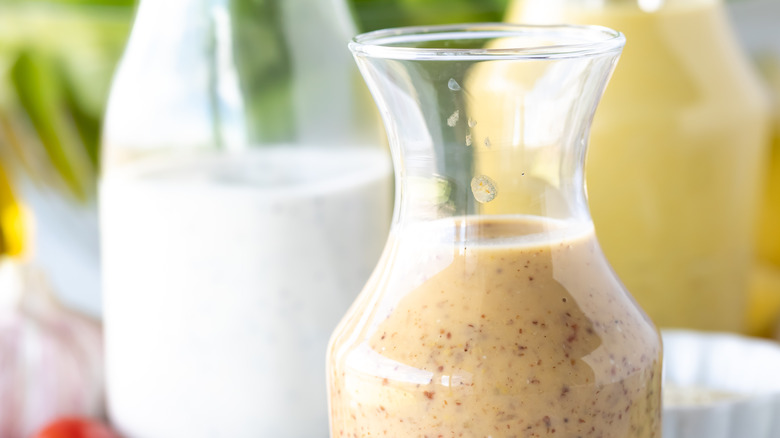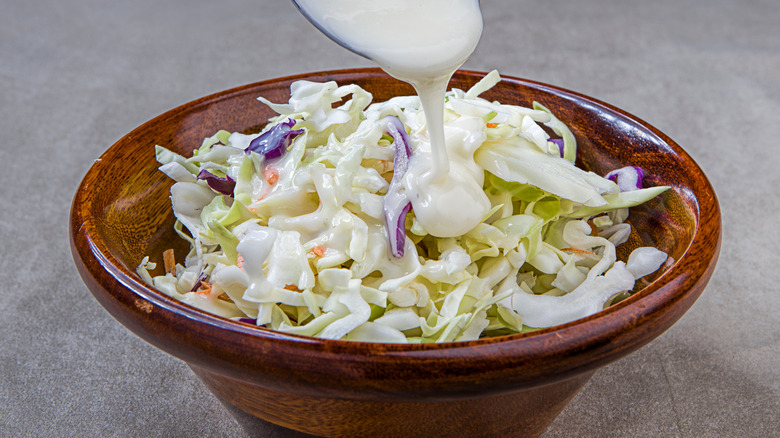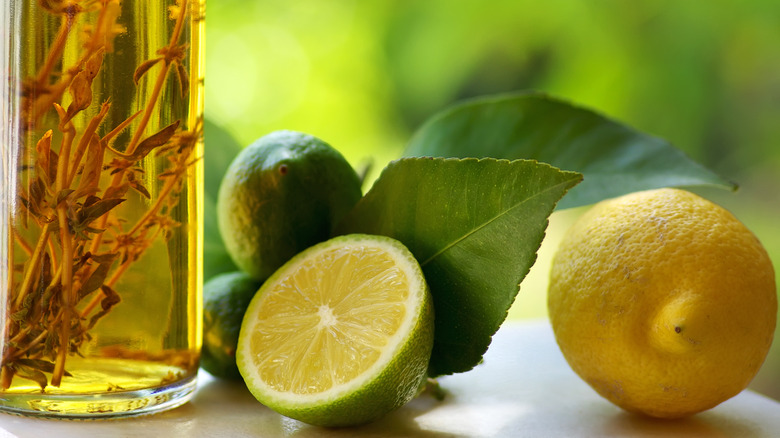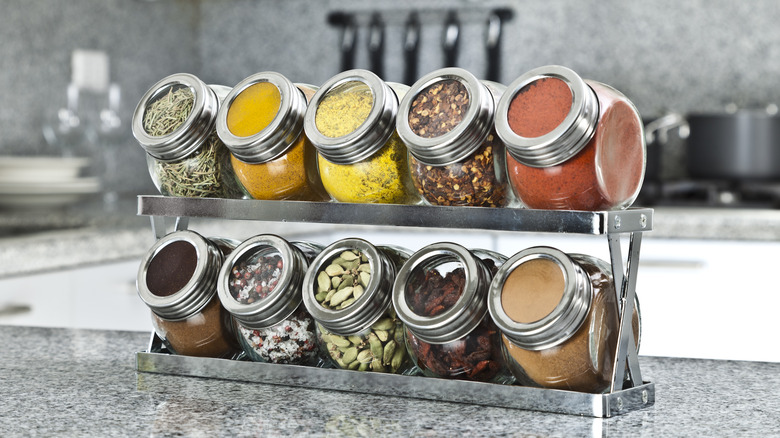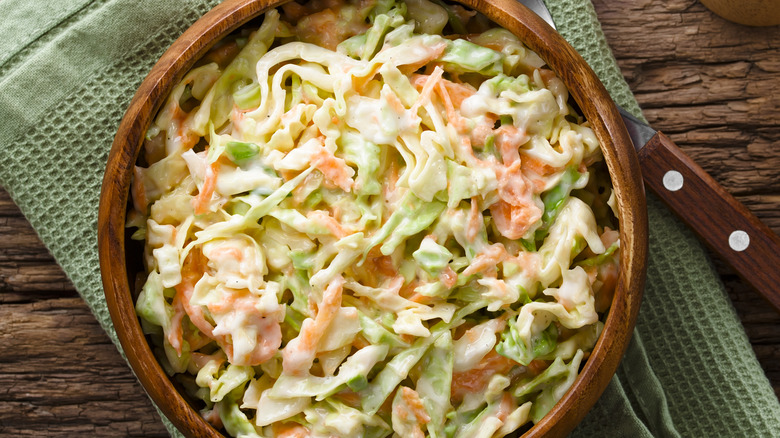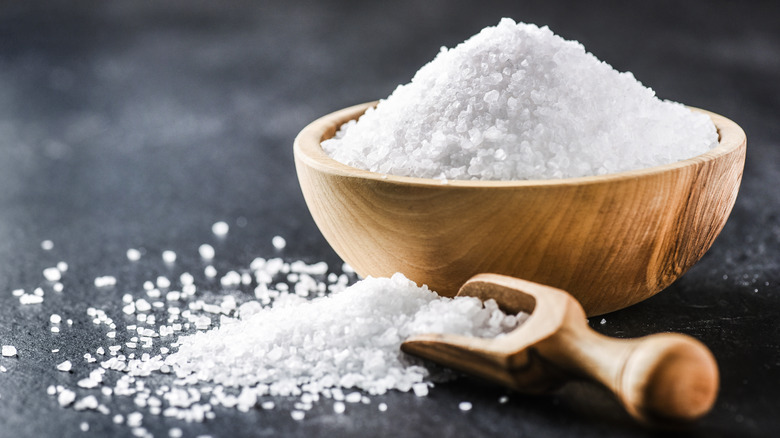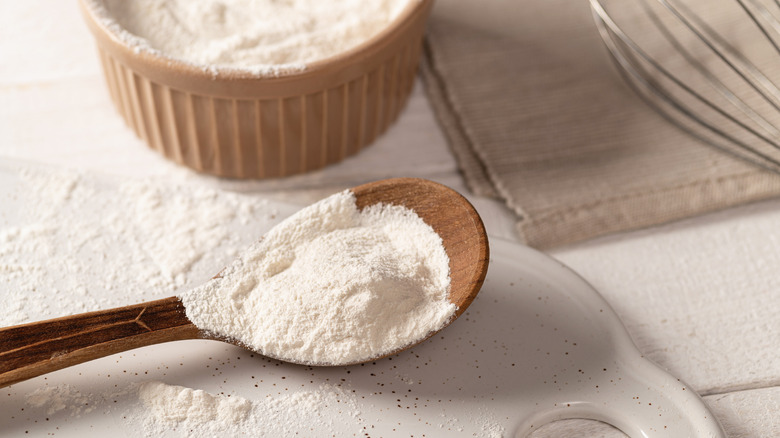Mistakes Everyone Makes When Preparing Coleslaw
It's crisp and crunchy, cool and refreshing, and sweet yet tart. It's at home next to a steak, perfect with burgers and sandwiches, and can even be a tasty snack on its own. You can get it at fine restaurants, late-night dinners, and everything in between. Yes, when it comes to classic side dishes, there's a lot to love about coleslaw.
Yet despite all the reasons we have to heap praise on this creamy delight — and all the delicious varieties of coleslaw that exist — some considerable challenges come with the dish. While coleslaw is affordable, always hits the spot, and might look easy to make, don't let appearances deceive you. Preparing great homemade coleslaw is an art. And that means that coleslaw also has its fair share of common pitfalls — mistakes chefs and home cooks of all experience levels make from time to time. This is why all of us occasionally end up being served a bowl of coleslaw that is bland, watery, sickeningly sweet, too tart, or just plain disappointing.
What are the folks who made these sad bowls of coleslaw doing wrong? How can you take such an amazing recipe and turn it so blah and mediocre? Keep reading to find out what these folks are doing wrong — and how you can avoid these same errors. That way, the next time you throw together a batch, you can be sure it will always be a mouthwatering and decadent delight.
Selecting the wrong cabbage
Making great coleslaw starts the minute you walk into your supermarket and begin selecting ingredients. Not surprisingly, this is also the exact moment when the biggest coleslaw blunders begin to occur. Number one among them? Picking out the wrong cabbage to make your coleslaw with.
Selecting the ideal cabbage is crucial for making great coleslaw because your choice of produce can significantly impact the texture, flavor, and overall quality of your recipe. While a supermarket might have dozens of varieties of cabbage available for sale at specific points of the year, try to stick to these three classic options.
Green cabbage is the most popular choice for making coleslaw and has a wonderfully mild, slightly sweet flavor that works wonderfully in almost any recipe. Red cabbage is another perfect option because of its vibrant color and the slightly peppery flavor it can bring to the side. The crinkled leaf Savoy cabbage is another ideal option, full of crunch and mild cabbage goodness. On the flip side, Napa cabbage, Chinese cabbage, and bok choy are less popular options for making coleslaw, primarily because their leaves are too soft and delicate and won't stand up as well to the coleslaw-making process. Once you settle on your variety of cabbage, always opt for the freshest heads possible. They should be firm, dense, and heavy with crisp, vibrant, tightly packed leaves. Older, overripe heads often have a more pungent smell and are more likely to taste bitter.
Lack of variety and crunch in your coleslaw ingredients
Once you've selected your cabbage, don't think you can immediately head for the self-checkout lane and call it a day on your shopping. In reality, your produce shopping has just begun. For coleslaw that genuinely packs a variety of flavors, textures, and colors — and plenty of crunch — your recipe should include several different types of fresh, in-season produce. Start your roundup with a bag of fresh carrots, which provide sweetness and incredible crunch when either diced or finely shredded. Bell peppers of all colors are another essential option for crunch as well as sweetness and tang.
Fresh radishes don't always get the culinary love they deserve, but these little fireballs are perfect for coleslaw, adding vibrant color plus a peppery kick. You should also consider grabbing some broccoli and cauliflower. Both can give a bit of earthiness to your coleslaw and will also make it lighter and fluffier, cutting through some of the density dressing-soaked cabbage can sometimes develop. Celery and jicama are both excellent for bringing a hint of savory flavor to coleslaw, as well as even more incredible crunch.
And finally, don't forget about slightly non-traditional coleslaw ingredients like green onion, snow peas, and even fennel. Each packs a unique vegetal flavor that will give your coleslaw an unexpected edge. And if you're looking for crunch, all three deliver it in droves, bite after lip-smacking bite.
Using too many strong-flavored veggies
As you browse the produce aisle, you may see other vegetables we haven't already mentioned and think, "Why not these guys, too? I bet they'd be great in coleslaw." But here's the thing: Not every vegetable works in every kind of salad. Take cucumbers and tomatoes. They're perfect for a light, refreshing garden salad with only a thin dressing layer. But they ultimately pack too much moisture for coleslaw. They'll leave the side bland and watery and will also dramatically cut down on the time it could be stored in the fridge if you were to use them. They're too delicate and simply fall apart in denser, more decadent salads like coleslaw.
Similarly, vegetables with an especially strong flavor profile are also poor choices for use in your average coleslaw. Consider raw garlic, for example. Its flavor is too potent and pungent for a light, fresh dish like coleslaw. It would overpower all the other ingredients. And while green onions and chives are an excellent coleslaw option because of their relatively mild flavor, raw onions — especially potent reds and whites — are also a definite no-no. They, too, simply pack too much sharp, intense flavor.
Finally, spicy peppers like jalapeños or habaneros should only be used in coleslaw in exceedingly small amounts, if at all. If not used sparingly, they, too, are just so peppery and so full of flavor that they will end up dominating your dish.
Not properly washing your cabbage
Once you get your fresh coleslaw ingredients home, you must give all that produce a good wash before you start prepping your coleslaw. That, in itself, shouldn't be a good surprise. But here's the thing: many people don't wash cabbage. This comes from the same logic sometimes used with oranges, onions, or other fruits or veggies with an outer layer you don't plan on eating.
You're thinking, "If I'm going to peel away those outer layers and use what's underneath, why does my cabbage need a bath?" But the issue is that cabbage grows close to the ground, and dirt and debris can accumulate within the vegetable as it grows, as well as when it's being harvested and transported from farm to market. Plus, bugs love sweet vegetables like cabbage, so there's a chance there could be insects or worms trapped within that head of cabbage as well.
To clean cabbage more effectively, peel back those looser outer leaves — they're perfect for use in a compost bin instead of going directly into the trash. Next, you'll need to do more than just rinse the remaining head of cabbage under running water. Instead, cut your head of cabbage into quarters or wedges and submerge them into a bowl of cool water. Next, gently swirl each segment of cabbage around the bowl to help loose any dirt or debris that might be trapped inside. Now, you can rinse the cabbage under running water and pat dry.
Not salting or properly draining your cabbage
In addition to soaking and rinsing your cabbage, world-class coleslaw also requires some additional preparation steps. For starters, after washing your cabbage, you'll need to remove as much excess water from those damp leaves as humanly possible. Patting them dry once you remove them from the sink is a good start. But the cabbage should also be given time to drain properly. Put it in a colander or let it rest on a clean kitchen towel or paper towel and let that excess moisture continue to drain for a few minutes.
Once your cabbage is as dry as possible, it's time to bring out the salt. In addition to providing flavor to food, salt draws out moisture, making it an essential step if you want the crispest, crunchiest coleslaw possible. To apply the salt, simply sprinkle a bit over each of your quartered, drained cabbage sections. You'll need approximately 1 teaspoon of salt per pound of cabbage in your recipe — some for now and some later. Kosher salt and sea salt work best and will dissolve most evenly.
The remainder of the salt should be sprinkled over your cabbage once it has been shredded. Gently toss the shredded cabbage with your hands to ensure the salt is evenly distributed. Let the cabbage rest for at least 15 minutes. If they begin to wilt slightly, you'll know it's working — and that the salt is drawing even more moisture out of those cabbage leaves.
Cutting your veggies too large
Your veggies are clean. Your cabbage is drained and salted. Now comes the fun part. It's finally time to start preparing your coleslaw. But watch out: Another common coleslaw flub is just around the corner, and you don't want to fall victim to it.
For the best-tasting, most attractive — and most delicious — coleslaw possible, it's crucial that all your vegetables are now diced, cut, or shredded into the most uniformly sized pieces possible (inconsistently sized pieces lead to a weird texture that changes with each bite or that can even make the coleslaw more challenging to eat). While you could use a food processor for your dicing, all you need is a sharp chef's knife and a large, sturdy cutting board.
Start your dicing with cabbage. Lay your cabbage segments flat on the cutting board, cut side down. Then, slice the cabbage thinly using parallel cuts across the width of the head. Aim for your shreds to be approximately ¼ to ⅛ of an inch thick for an ideal balance between tenderness and crunch. Continue slicing until all the cabbage you plan on using has been shredded. After the cabbage, move on to your carrots. They should be peeled and cut into matchsticks or thin julienne strips approximately the same width as your shredded cabbage and about one-third to half the length of those shreds. Finally, move on to your other veggie ingredients, all of which should be diced into small, uniform pieces.
Opting for premade dressing instead of making your own
Once you've gone through the hard work of selecting a variety of fresh, beautiful produce, washing it, and dicing or shredding it to perfection, it would be a shame to simply mix those ingredients and then douse them with a premade coleslaw dressing from the bottle. This is especially true when homemade dressings are quick and easy to blend on your own and allow for all sorts of individualization and customization to make your coleslaw uniquely "you."
For instance, to craft a classic creamy coleslaw dressing filled with richness and tang, combine 1 cup of mayonnaise plus 2 tablespoons each of apple cider vinegar and Dijon mustard. You can add 2 tablespoons of honey for a slightly sweeter dressing. Or, for a more savory dressing, add ½ teaspoon of celery seed plus salt and pepper to taste before mixing.
Or, if you like your coleslaw with a zesty citrus twist, try whisking together ½ cup mayonnaise, ¼ cup of plain Greek yogurt, 2 tablespoons of fresh lemon juice, and a tablespoon of honey. To customize this dressing, you might also add 1 teaspoon of poppy seeds or the zest of an orange or lime for an even more elevated pairing of flavors. And if you like heat, make a spicy Sriracha-lime dressing combining ½ cup mayonnaise, 2 tablespoons sour cream, 1 tablespoon Sriracha sauce, and the zest and juice of 1 lime (to balance the heat, you can also stir in a drizzle of honey).
Dressing mishaps
With your homemade dressing in hand, it's now time to coat those wonderful diced veggies. For coleslaw made with one full head of cabbage plus additional vegetables, you'll typically need about 1 cup of dressing to start. This might seem modest, but remember: You can always add more. One of the biggest mistakes rookie chefs tend to make is adding too much dressing to their coleslaw all at once. Only after the dressing is added do they realize they've used too much. And at that point, there's no going back — you're just stuck with a soggy bowl of cabbage.
To combine your coleslaw and dressing, grab your biggest mixing bowl and dump in all your diced vegetables. Then, slowly pour in part of your dressing. Toss the vegetables and dressing gently. Your goal is to make sure everything is evenly coated with a thin layer of dressing. If you haven't added enough dressing, pour in some more and toss again. You're looking for an ideal balance — not too dry and not too wet. This will vary by individual tastes, so sample the coleslaw as needed while you mix and use your judgment. Keep adding dressing and tossing until the coleslaw tastes just the way you like it.
If possible, try to keep some additional dressing on hand once you hit that perfect sweet spot of saturation. The vegetables in the coleslaw will absorb some of the dressing over time, so you may need to add more later on.
Lack of balance in your coleslaw
One of the most essential aspects of a good bowl of coleslaw — and one of the areas where many people make mistakes — is preparing a version of the side that simply lacks balance. It may be too sweet or too acidic. Or it just tastes bitter. Ultimately, you just know it's off in some way. When this happens, take heart. All is not lost. Even if your coleslaw has already been made, there are some tips and tricks you can try to add a sense of balance back to even the most flawed of recipes.
If your coleslaw is too sweet, try to counterbalance that excess sweetness with acid. Add a splash of apple cider vinegar, white vinegar, or freshly squeezed lemon or lime juice. Or, for an acidic tang, stir in a dollop of mustard. Do you have the reverse problem, and your coleslaw is simply packing too much tart bite? In that case, a drizzle of honey could be your best friend. Spread it over the coleslaw and toss well. You could also add grated apple, finely diced pineapple, or even a sprinkle of sugar. Just be careful not to be too heavy-handed — a little sweetness goes a long way.
Bitterness is another common problem with coleslaw. Sweeteners like honey and fresh fruit should also help to counteract even a stubborn bite. Or, you can attempt to mellow the bitterness by adding a splash of OJ to the coleslaw and mixing it in well.
Neglecting to add enough spices or seasoning
Maybe it's not bitterness or lack of balance that's screwing up your coleslaw. Perhaps the recipe you followed is just inherently bland. If your dressing is already applied, you only have one choice left to turn your coleslaw around. You've got to add some seasoning or spice.
Start by adding salt and pepper to taste. It's amazing how often even the most experienced chef who is in a rush can forget to add enough salt and pepper to something. Even a bit of each is sometimes all you need to turn a "meh" dish into something you can't wait to gobble up a second helping of. Sprinkle ½ teaspoon salt and ¼ freshly ground black pepper over your coleslaw, toss the ingredients well, and give it a taste. If you feel the coleslaw is still lacking the flavor you're after, it's time to move on to individual ground spices.
Paprika is a wonderful option for giving a mild kick of flavor to all sorts of creamy sides, from potato and pasta salad to delicious, creamy coleslaw. Sprinkle ½ teaspoon over the coleslaw and toss until well combined. For smoke plus heat, go with smoked paprika instead. Try adding ¼ teaspoon of cumin to your coleslaw for a bit of earthy, umami flavor. Or, for added savory flavor, try ½ teaspoon onion or garlic powder. You can also experiment with coriander, thyme, parsley, dill, mustard powder, and cayenne pepper. All are great for helping to make bland coleslaw shine.
Not letting your coleslaw chill before serving
Your perfectly flavored, lovingly prepared coleslaw is now ready to serve. There's only one step left: getting it on the plate. But there's a common mistake that can be made here, too and one that is especially easy to avoid. The secret? Don't serve your coleslaw immediately after you make it. Instead, think of coleslaw more like a fine cheese or wine that needs some time to age and let its flavors meld and come together. Fortunately, unlike those gourmet products, coleslaw doesn't require years in a cold cellar. It just needs a minimum of 15 to 20 minutes spent chilling out and relaxing in the fridge.
This brief cooling period gives your dressing time to soak into the diced and shredded veggies in your coleslaw and make them more tender and flavorful. It also allows time for the spices and seasonings within the dish to interact with one another, creating a more harmonious and well-balanced flavor profile. Plus, coleslaw is always more refreshing and enjoyable when it's nice and cold, especially if you're serving it on a warm day.
But because it's perishable at room temperature, remember that any leftover coleslaw should also go back into your fridge after everyone has been served. To avoid food-borne illness, don't leave it sitting at room temperature for more than two hours maximum. Kept cool in your fridge, most coleslaw will last three to five days before starting to go bad and spoil.
You used too much vinegar, salt, or sugar in your coleslaw
It might seem like your coleslaw is riding the fast track to the dumpster if it tastes too vinegary, salty, or sweet. But fear not, we have the solution for each of these slaw-mergencies.
Too vinegary means acid has taken over the flavor profile. To balance that out, add a fat like olive oil, or extra mayo, or even something sweet like honey, or a little sugar. Dolly Parton uses sweet pickle juice in her recipe, which just might do the trick. Too salty? Grab that vinegar. Acid balances salt, so even a squeeze of lemon could also work wonders. And, once again, fats work well here too. If your coleslaw is tasting way too sweet, citrus or vinegar acids do the job. You can also add extra cabbage or other veggies to bulk up and dilute the overwhelming flavor, along with a dollop of Greek yogurt instead of mayo.
Whichever direction you're trying to go as far as taste, take it easy on the add-ins, and remember to taste as you go. We got here by playing it too fast and loose with our seasonings. We get ourselves out of this (soon to be delicious) mess by going slow and steady in the direction of our coleslaw dreams.
You forgot the xanthan gum for the coleslaw dressing
Real talk, most of us can't say the name of this ingredient. But even though it might be hard to pronounce, xanthan gum (ZAN-thin, btw) is safe and easy to cook with. It's just one of many unique ingredients that make your coleslaw so much better. But here's why X marks the spot.
Made of glucose and fermented bacteria found on veggies, powdery xanthan gum works as a thickening agent, even in very small amounts. It's commonly used in the food industry, beefing up everything from pasta sauces, to salad dressings, and ice cream (just check the ingredient label next time you buy one of those). For your coleslaw recipe, mix a sprinkle of xanthan gum into the dressing before you toss the salad. You might notice that it adds a certain je ne sais quoi, kind of like a cult-favorite coleslaw you might find at a restaurant.
This is one where you want to start off easy with the xanthan gum, and gradually add more if your dressing needs it. Protect the cornbread and burger buns of the world by never sogging them up with neighboring watery coleslaw, ever again.
You didn't microwave the cabbage for your coleslaw
Nuking your cabbage might seem like the world's No. 1 worst cooking tip, but when it comes to prepping coleslaw, it's one of the hottest methods around. It slashes your cook time — and eliminates the potential for sloppy slaw.
You may have once been served a coleslaw recipe that puddles on your plate, losing all of its dressing, and with it, all of the flavor. That extra liquid most often comes from the cabbage itself, which is packed with water. The traditional strategy for eliminating this excess moisture is to sprinkle the cabbage with salt and let it rest for hours before draining it. But, hi, we're hungry and we need that slaw on the table, stat. For cabbage in a snap, see: microwave.
Shred your cabbage (about the amount of one head), and toss it with a little salt and sugar. Then pop it in the microwave for a few minutes, just until it begins to wilt, take it out, let it cool, and drain it. You can do this with a tea towel wrap and twirl, or any other method you like for spinning the water out of your veggies. Then, proceed to add your favorite ingredients and dressing for a show-stopping take on your favorite coleslaw recipe.

